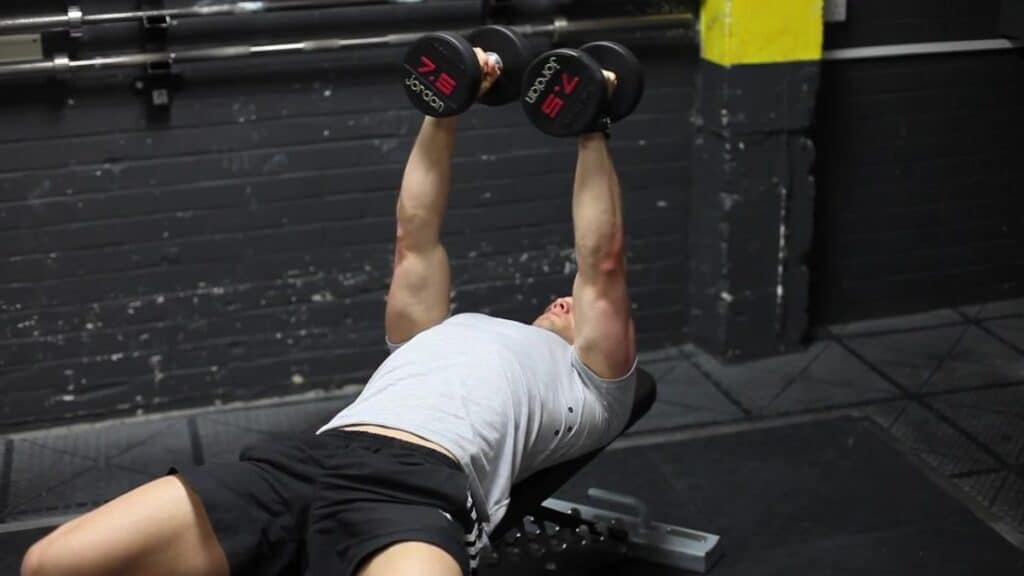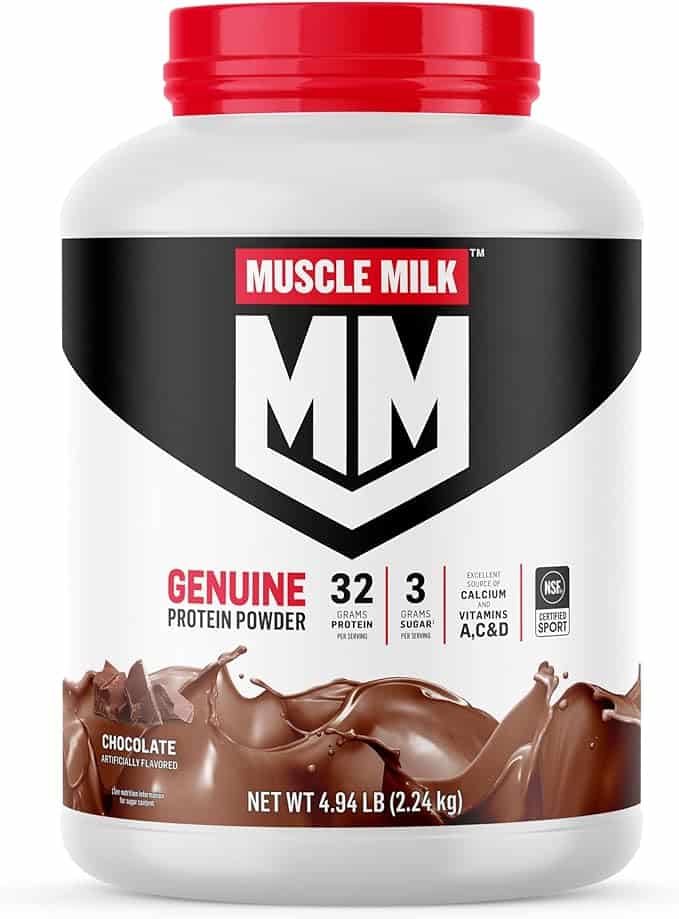
The dumbbell fly is a cornerstone exercise in strength training and bodybuilding, yet its significance often goes unrecognized. Dumbbell flyes play an instrumental role in developing chest muscles, increasing strength, improving posture, and enhancing overall wellness. Our comprehensive guide will delve into the intricacies of the dumbbell fly, shedding light on its profound impact.
We will provide a guide for performing the dumbbell fly and recognizing muscle activation during the exercise. We’ll also explore using this exercise to increase strength or build muscle. Also, look for our tips on incorporating drop sets into your routine to elevate your dumbbell chest fly sessions to new heights.
How Does it Work?
Whether you’re seeking to build upper body strength or improve core stability, understanding the mechanics of a well-executed dumbbell fly is key. Stay tuned as we unravel the effectiveness of this great exercise with the use of dumbbells for building chest muscles and pectoral strength.
The Importance of Dumbbell Flys in Strength Training, Bodybuilding, and Overall Wellness
Don’t overlook the dumbbell chest fly. This exercise is a powerhouse for developing your pecs and other arm-assisting muscles. Whether you’re an athlete or just want to improve your overall wellness, incorporating dumbbell flys into your routine can yield significant gains.
#1 Targeted Muscles
Dumbbell flys target your chest, shoulder, and upper arm muscles. Especially the pectoralis major muscles. These are commonly known as pecs, or chest muscles. Developed pectoral muscles give your chest a well-defined and stronger look.
This exercise adds a unique twist of flexion and adduction to stimulate those muscles in a whole new way. Combine flyes with push-ups and bench presses to give your body a well-rounded chest workout. Your core is activated as your body requires stabilization. Therefore, a side effect of this workout is improved core strength.
This exercise also activates the anterior deltoid muscles (the front of your shoulder muscles) and biceps brachii (your upper arm muscles). Your shoulders, chest, arms, and core are all working together as you do the dumbbell fly.
#2 Good Posture
Not only do dumbbell flies build impressive pecs, but they also improve your posture. Strengthening your shoulder girdle helps keep your shoulders back and prevents that dreaded forward rounding. Say goodbye to slouching and hello to a pain-free back and injury prevention.
Incorporating dumbbell flies into your fitness regime is more than just about looking good; it’s about enhancing functional strength and maintaining good health too. Next time you hit the gym, don’t neglect to include a few sets of dumbbell flyes – your body will be thankful for it.
Step-by-step Instructions to Perform a Dumbbell Fly
The dumbbell fly is a great exercise to build upper body strength, especially in the chest muscles. Here’s how to do it right:
Preparing for the Exercise
Grab a pair of dumbbells that challenge you, but start with a manageable weight. If this is your first attempt, start with 5 to 15-pound weights and focus on your form. Lie down on a flat bench with your feet planted firmly. Hold the weights close to your chest with palms facing each other. For proper form have your upper back flat on the bench. Your back muscles will not be activated, so they should remain neutral.
Performing this exercise on a Bosu ball will require more focus on stability and will add intensity. Bosu balls are half of an inflated exercise ball that provides an unstable surface and therefore provides more input to your overall core strength.
Executing Proper Form- How to Do the Dumbbell Fly
#1 Set Up and Form
The Dumbbell fly is a single-joint movement, therefore starting with light weight is important. Do not hinge at the elbow, but do not keep your elbows locked out either. Keep your elbow fixed with a slight bend throughout the movement. (an approximately 10-degree bend) Keep your elbow turned up all the way through the movement. Do not rotate the arms, as you may experience stress in the elbow.
#2 Points of Contact
Pick up your dumbbells, and sit on the bench. You will want to have your feet planted on the ground underneath your knees and have your dumbbells resting on your knees. When you start leaning back, use your knees to hoist the dumbbells above your head as you will put your back, and head flat on the bench.
#3 The Movement
Keep your elbows fixed at a slight bend and open up your chest as you move the dumbbells. Keep the movement slow and controlled.
#4 Depth
Lower the dumbbells until you feel a good stretch. Do not extend past that feeling, as you may start feeling a strain on your joints. Lower the dumbbells as far as you can before deviating from your form.
#5 Repeat
- Lift: Push those dumbbells up toward the ceiling, using your elbows, not your wrists.
- Squeeze: Squeeze your pecs together like you’re trying to hold a sandwich between them. Keep those weights close. Feel the burn in your chest, back, and shoulder blades.
- Fly: Slowly lower the weights outwards, keeping a slight bend in your elbows. Don’t let those dumbbells fly away.
- Pull Back: Contract your pecs and pull the dumbbells back up, completing one rep of the dumbbell chest fly exercise.
Incorporate different dumbbell fly variations, like incline or decline flies, to level up your upper body strength and get those pecs poppin’. And remember, keep your shoulders back and engaged throughout the exercise to avoid any shoulder strain and maintain good posture. Complementary exercises to add would be the bench press or upper back exercises. Respect everyone’s space and put your dumbbells back when you’re done.
Effectiveness of Dumbbell Chest Fly Exercise
The dumbbell chest fly is more than just a warm-up or cool-down activity. It’s like a superhero that saves your posture and prevents back pain. This exercise is essential to include in your fitness regimen. The workout provides activation in the chest primarily but still is effective in the shoulders, upper arms, and core.
Benefits Beyond Preparation and Recovery
The dumbbell fly isn’t just for show. It’s a powerhouse that improves mobility, boosts core stability, strengthens shoulders, defines your chest, and brings balance to your muscles. The dumbbell fly offers athletes a comprehensive approach to both physical appearance and well-being.
Maintaining Mobility through Regular Practice
Consistency is key, my friend. Regularly practicing exercises like the dumbbell chest fly keep your joints flexible and your supporting muscles strong. It’s a game-changer for runners who need upper-body strength and desk warriors who want to avoid back pain.
Understanding Muscle Activation During Dumbbell Flyes
The dumbbell fly targets the pectoralis major muscle group, giving you a chest that’s as impressive as a peacock’s feathers. But wait, there’s more. It also works those sneaky secondary muscles like the pec minor, serratus anterior, and subclavius. They may be secondary, but they’re still important. You will feel the strain in
Promoting Muscular Balance Through Targeted Activation
When you activate those secondary muscles during dumbbell flyes, you’re not just showing off. You’re promoting muscular balance in your upper body. It’s like having a perfectly balanced meal but for your muscles. And guess what? This balance can improve your performance in other exercises and daily activities. It’s a win-win situation.
Increasing Shoulder Strength vs. Enhancing Definition
The dumbbell fly exercise can be incorporated into strength training and bodybuilding routines. If your goal is to increase strength, include high intensity in the weight of the dumbbell combined with a small number of reps and full rest between sets. If you want to build a chest, increase the volume of reps and sets.
Increasing Strength
The key to increasing strength with the dumbbell fly would be to to 1-5 reps at 80%-100% of your max effort. You can do multiple sets, but make sure you have plenty of rest.
Body Building
To build your chest and upper shoulders with the dumbbell fly movement do 3 to 6 sets of 6 to 12 reps at 60%-80% effort. Give yourself plenty of rest between sets.
If you’re ready to take your fitness game up a notch, try adding the movement into your routine for improved posture and strength. Your body will be grateful, and you’ll be nearer to achieving the ideal version of yourself. Now, go out there and fly high.
Incorporating Drop Sets into Your Routine
Drop sets, a technique often used in strength training and bodybuilding, can seriously amp up your workouts. This method involves doing two exercises back-to-back with minimal rest. It’s a killer way to crank up the intensity and get those gains.
Benefits of Doing Two Exercises Back-To-Back with Minimal Rest
- Muscle Growth: Drop sets keep those muscles under constant tension, promoting serious growth.
- Athletic Performance: Regular drop-set training improves overall athletic performance and endurance.
- Better Core Stability: Drop sets engage your core, helping to improve stability over time.
- Muscular Balance: By targeting different muscle groups simultaneously, drop sets promote better overall balance.
- Gains in Shoulder Strength & Definition: Incorporating dumbbell fly exercises into drop sets can give you killer shoulder strength and definition.
If you’re looking to level up your fitness game, try incorporating drop sets into your routine at least twice a week. Just remember to maintain proper form and consult with a professional trainer if you’re new to this technique or have any health concerns. For more detailed information about safe practices while doing high-intensity workouts, check out this guide from Healthline.
FAQs in Relation to Dumbbell Fly
Are dumbbell flys effective?
Yes, dumbbell flys are highly effective for developing chest muscles and improving shoulder strength.
What are the cons of a dumbbell fly?
The main downside is a potential strain on your shoulders if performed incorrectly. Proper form is crucial in dumbbell fly exercises.
Can you do dumbbell Flyes every day?
No, it’s recommended to allow muscle recovery time between workouts. Overtraining can lead to injury. Refer to this guide on muscle recovery and growth. Give your body a day or 2 to recover.
What do dumbbell flyes build?
Dumbbell flyes primarily build pectoral muscles but also engage the deltoids and biceps. Learn more about these exercises at this comprehensive chest exercise resource.
Conclusion
It builds chest muscles and improves posture.
Follow the step-by-step instructions and nail the proper form to get the most out of this exercise.
Dumbbell flyes offer benefits like mobility and muscular balance through targeted activation.
Don’t forget to incorporate drop sets for even stronger shoulders and definition.
So, don’t underestimate the power of the dumbbell fly in your strength training routine!
Read more: How to Bench Press
Tags: dumbbell, dumbbell flies, dumbbell flyes, dumbbells, flyes, weight lifting, Weight Training, weightlifting










